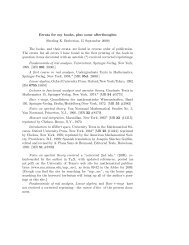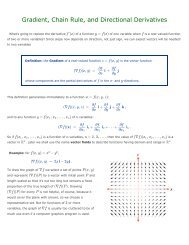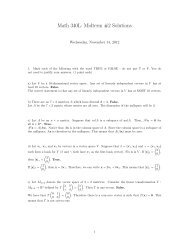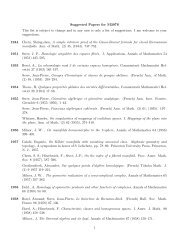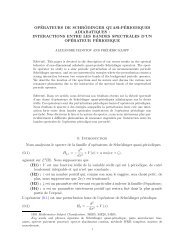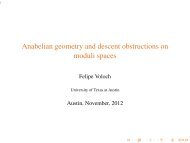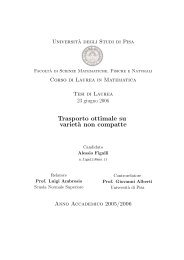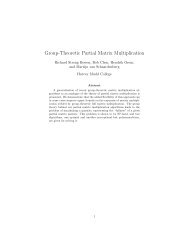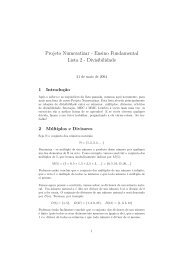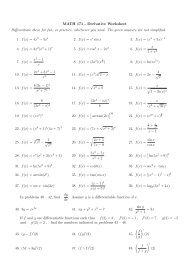Optimal transport, Euler equations, Mather and DiPerna-Lions theories
Optimal transport, Euler equations, Mather and DiPerna-Lions theories
Optimal transport, Euler equations, Mather and DiPerna-Lions theories
You also want an ePaper? Increase the reach of your titles
YUMPU automatically turns print PDFs into web optimized ePapers that Google loves.
1.4. REGULARITY OF THE OPTIMAL TRANSPORT ON RIEMANNIAN MANIFOLDS17<br />
In the above formula the cost function is evaluated at (x, y), <strong>and</strong> we used the notation cj = ∂c<br />
∂x j ,<br />
cjk = ∂2 c<br />
∂x j ∂x k , ci,j = ∂2 c<br />
∂x i ∂y j , c i,j = (ci,j) −1 , <strong>and</strong> so on. The condition to impose on S (x,y)(ξ, η) is<br />
S (x,y)(ξ, η) ≥ 0 whenever <br />
ci,jξ i η j = 0<br />
(this is called the MTW condition).<br />
As shown by Loeper [57], the MTW tensor satisfies the following remarkable identity:<br />
S (x,x)(ξ, η) = − 3 ∂<br />
2<br />
2<br />
∂s<br />
∂ 2<br />
ij<br />
|s=0 2 ∂t2 |t=0F (t, s) = Sectx([ξ, η]),<br />
where ξ, η ∈ TxM are two orthogonal unit vectors, F (t, s) := 1<br />
2 d exp x(tξ), exp x(sη) 2 , <strong>and</strong><br />
Sectx([ξ, η]) denotes the sectional curvature of the plane generated by ξ <strong>and</strong> η. This fact shows<br />
that the MTW tensor is a non-local version of the sectional curvature, <strong>and</strong> the MTW condition<br />
implies non-negative sectional curvature. Loeper also showed that the MTW condition is indeed<br />
a necessary condition for the regularity of the optimal map. In particular, regularity cannot hold<br />
on manifolds which have a point x where the sectional curvature of a plane in TxM is negative.<br />
In collaboration with Gregoire Loeper [18], I proved a regularity result in two dimension for<br />
optimal maps under weak assumptions on the measures:<br />
Theorem 1.4.1 Let (M, g) be a two-dimensional manifold. Assume that the MTW condition<br />
holds, that f ≤ A <strong>and</strong> g ≥ a for some A, a > 0 on their respective support, <strong>and</strong> that the cost function<br />
c(x, y) is smooth on the set supp(µ) × supp(ν). Finally suppose that (exp x) −1 (supp(ν)) ⊂<br />
TxM is convex for any x ∈ supp(µ). Then T is continuous.<br />
We remark that this result is “local”, in the sense that the assumption that c is smooth on<br />
supp(µ) × supp(ν) means that we stay away from the cut locus.<br />
In the general case one has to deal with singularity of the cost function, which makes things<br />
much more complicated. It turns out that the convexity of cut-loci is useful to prove regularity<br />
<strong>and</strong> stability results. For this reason we give the following definition:<br />
Definition 1.4.2 Given x ∈ M <strong>and</strong> v ∈ TxM we define the cut time as<br />
tc(x, v) := inf {t > 0 | s ↦→ exp x(sv) is not minimizing between x <strong>and</strong> exp x(tv)} .<br />
We say that (M, g) satisfies CTIL (Convexity of the Tangent Injectivity Loci) if, for all x ∈ M,<br />
the set<br />
TIL(x) := {tv ∈ TxM | 0 ≤ t < tc(x, v)} ⊂ TxM<br />
is convex.<br />
Combining (a strengthened version of) the MTW condition (called MTW(K, C)) with CTIL,<br />
Loeper <strong>and</strong> Villani proved the continuity of the optimal map [58]:



